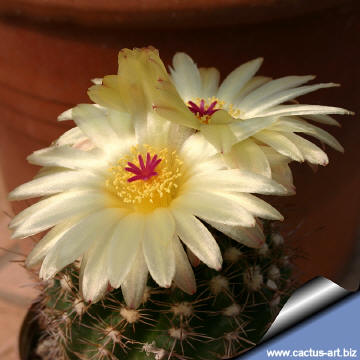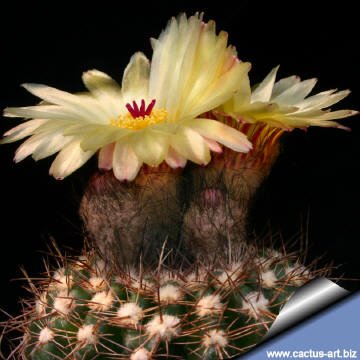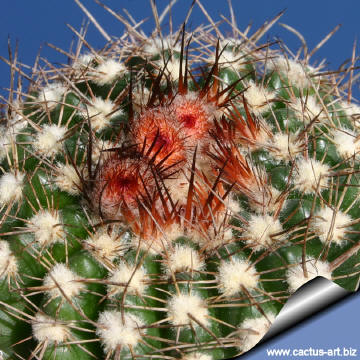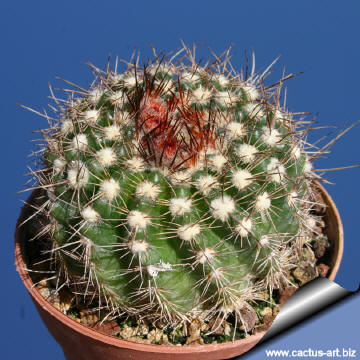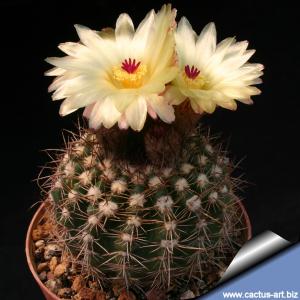Pianta normalmente solitaria con fusto sferico e depresso, i grandi fiori giallo brillante hanno la lucentezza della seta. Family: Cactaceae (Cactus Family)
Subfamily: Cactoideae
Tribe: Notocacteae Notocactus bommeljei Van Vliet,
In. Succulenta 47: 7. 1968.
Holotypus: tab. 50, fig. 2 in Mart. Fl. Brasil. 4(2). 1890.
Accepted Scientific name: Parodia tabularis subsp. bommeljei (Vliet) Hofacker 1998 (Cels ex Rümpler) D.R.Hunt 1997
Origin: The N. bommeljei comes from Brazil (Rio Grande do Sul) Conservation status: Listed in CITES appendix 2. Etymology: Named after C. Bommeljé friend of Dirk van Vliet. Synonyms: - Parodia tabularis (Cels ex Rümpler) D.R.Hunt 1997
- Echinocactus tabularis Cels ex K.Sch.
In: Gesamtb. Kakteen, p. 389, 1899 - Malacarpus tabularis (Cels ex Rümpler) Britton & Rose In: The In:Cactaceae, 3 : 193, 1922
Notocactus tabularis (Cels ex Rümpler) A.Berger ex A.W.Hill 1933 In: Kakteen: 211, 343. 1929 - Notocactus tabularis ssp. tabularis (Cels ex Rümpler) Backeberg
In Backeberg et Knuth, Kaktus ABC, p. 255, 1935 - Echinocactus muricatus K. SCHUMANN
In: Gesamtbeschr. Kakt. 386 (1898), non Otto ex Pfeiff. (1837) - Notocactus muricatus Hort.
- Notocactus tabularis ssp. muricatus (Doweld) Doweld, comb. nov.
- Peronocactus tabularis ssp. muricatus Doweld
In: Sukkulenty 1999(2): 21-22 - Echinocactus concinnus var. tabularis Cels ex Rümpler
In Förster et Rümpler, Handbuch der Cacteenkunde, p. 552, 1886 - Notocactus brederooianus Prestlé 1985
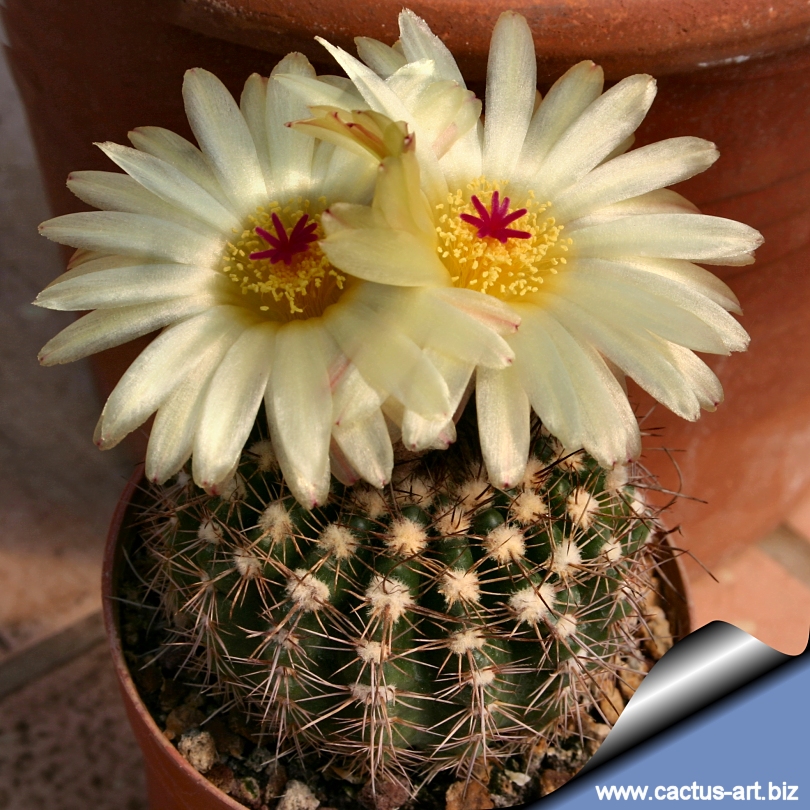 Notocactus bommeljei Notocactus bommeljei
It has expressive shining yellow flowers.
|
| Description: Parodia (Notocactus) tabularis is a usually solitary, or slowly clustering, flattened ball-shaped cactus. This taxon has been known for decades in cultivation, but a definitive description from plant located in habitat has been made by Dirk van Vliet only in 1968. It is indeed known in older description under the name of Echinocactus muricatus 1837.
Stem: Up to 8(-10) cm across, glaucous blue-green, spherical to short cylindrical, ± flattened apically.
Ribs: 16-23 low, obtuse.
Central spines: 3-4 up to 12 mm long, thin, white with brown to dark-red tips, ± curving, forming a cross. New spines red.
Radial spines: 12-18 up to 10 mm long needle-like, sreading.
Flowers: Diurnal, opening in during the day and closing at night. Yellow flower, 5-6 cm in diameter. Floral tube with whitish wool and long brownish bristles.
Blooming season: Spring to early summer.
Fruit: Oval, yellowish green, up to 1.2 cm long and 0,7 cm in diameter.
Seeds: Cap shaped, black tuberculate, ± 1 mm in diameter.
Parodia tabularis comprises two subspecies:
subsp. tabularis: With 16-18 radial spines and 4 central spines. Origin:Brazil and Uruguay
subsp. bommeljei: With approx 12 radial spines and 3-4 central spines. Origin: Rio Grande do Soul, Brazil.
|
| Cultivation: This is an easy plant to cultivate. It require a mineral-based potting mix with a good drainage. Can support quite some water during the growing season but pot plants in winter are wet-sensitive and needs to be kept dry (rots easily if soil is wet and cold). Usually it is recommended to over-winter this plant in a bright and warm greenhouse with at least 8-10° C , but it has proved to tolerate temperatures as low as -5° C for short periods.
Sun Exposure: Light shade to full sun but doesn't like full, hot blazing sun in the central summer month. Propagation: Seeds, cuttings. Not too difficult to raise from seed. |
